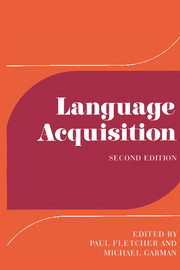Book contents
- Frontmatter
- Contents
- Contributors
- Preface
- Part I Contexts and determinants
- Introduction
- 1 Psychosocial aspects of language acquisition
- 2 Language acquisition and cognition
- 3 Language acquisition and linguistic theory
- 4 Conversations with children
- 5 Learnability
- 6 Variation in child language
- Part II The development of linguistic systems: phonology
- Part III The development of linguistic systems: grammar
- Part IV Later language development
- Notes to chapters
- Bibliography and citation index
- General index
- Titles in the series
3 - Language acquisition and linguistic theory
Published online by Cambridge University Press: 05 June 2012
- Frontmatter
- Contents
- Contributors
- Preface
- Part I Contexts and determinants
- Introduction
- 1 Psychosocial aspects of language acquisition
- 2 Language acquisition and cognition
- 3 Language acquisition and linguistic theory
- 4 Conversations with children
- 5 Learnability
- 6 Variation in child language
- Part II The development of linguistic systems: phonology
- Part III The development of linguistic systems: grammar
- Part IV Later language development
- Notes to chapters
- Bibliography and citation index
- General index
- Titles in the series
Summary
Perhaps the best introduction to the topic of language acquisition and linguistic theory is a look at some of the facts that linguistic theory must account for. The complexity, orderliness and limited variety in human languages convinces linguists that language must be learned through a biological program that puts bounds on the possible grammatical system a child can postulate. The type of system that falls within the bounds of this innate learning ability is the matter of linguistic theory.
Some properties of human languages
Order and dominance
Sentences are strings of words. One of the ways in which languages differ is in the ordering relations and type of hierarchical structure that is imposed on words in sentences. Languages divide into so-called free word order languages and those that impose relatively rigid word orders on sentences, selecting one of the three basic word orders characteristically found in human languages. English has a basic Subject–Verb–Object (hereafter SVO) order (Ants eat ants etc.). The other two primary orders selected by languages are Subject–Object–Verb (SOV) and Verb–Subject–Object (VSO).
The choice of a system with relatively free versus fixed word order determines many important properties of a language's design. In free word order languages the words are concatenated with little superstructure; languages with more or less fixed word order in general permit the embedding of sentences and phrases one within the other, resulting in hierarchical structures of potentially infinite depth.
- Type
- Chapter
- Information
- Language AcquisitionStudies in First Language Development, pp. 49 - 68Publisher: Cambridge University PressPrint publication year: 1986
- 9
- Cited by



